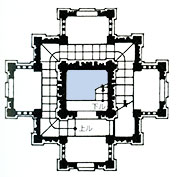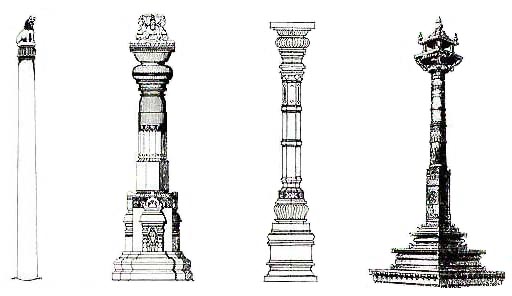|
JAINA ARCHITECTURE
|
TAKEO KAMIYA
|
JAINA ARCHITECTURE
|
There is a long stretched hill of about 150m-high in Chittorgarh (*1) of North India. This is the citadel of Chittorgarh, which was once reputed as impregnable in the era of the Mewar Kingdom. Heroic battles fought here against Muslims of Delhi left tragic tales which have been passed down from generation to generation for a long time. When defeat seemed certain after several times of offensive and defensive battle, the queen along with her thousands of women in the citadel threw themselves into a fire to keep their chastity, and thousands of soldiers took to the field and died in the battle. At present, there is a small village, many temples and palaces as well as water related structures left half ruined on the hill. Above all, two towers attract our attention. One is called "Kirti Stambha" (Tower of Fame), the other is called "Jaya Stambha" (Tower of Victory). Against our expectations, there is no tower except these two towers in Chittorgarh, older than minarets in the times of Islam or clock towers built under British rule. These two towers are all the more rare and valuable in this regard. Kirti Stambha is older than the other, and it seems to have been built in the 13th century. The tower soars to 24m-high and has seven stories on the basement. The top floor is an observation hall, from which we can command a view of not only inside the citadel, but also surrounding plains and the horizon. This tower is dedicated to the first Tirthankara (Jina) Adinatha. In each niche of four faces at the 2nd story, his statue is enshrined.
  Kirti Stambha (Tower of Fame), Chittorgarh What distinguishes this tower from other stone masonry ones in the world would be its ingenious formation. Since it is rather difficult to build a tower by masonry, most of them have simple shapes that directly reflect the structural form. However, this Jaina tower has extremely complicated formations: it is covered with carvings of the statues of Jina and others, has a shaft of combination of narrow and thick parts, and shaded by niches and balconies. A kind of taste similar to expressionism is seen in this unparalleled design. Another notable attraction is its interior. Jaya Stambha is more remarkable in this respect. An inscription indicates that King Rana Kumbha built it in 1448 to commemorate a victory in a battle against Muslims. Since it was built after its model of the other one, it developed into a nine story, 37m-high tower.

The interior of the tower is more spacious, and it is possible to climb up staircases without bending our bodies. These staircases are not just a simple spiral type. The tower plan consists of two concentric squared walls, which provides a way of climbing full of variety. When we finish climbing up the central spiral staircase for one floor, next we walk up a corridor and steps along the outer walls. Then again we go up the central spiral staircase.

While the Tower of Victory is larger than the Tower of Fame, its design is rather monotonous, and despite the fact that engravings are more plentiful, its attraction as a whole is lower than the other. The tower is dedicated not to Jina, but to Vishnu, the Hindu God. And yet, when comparing these two towers, there is scarcely any difference between them from an architectural point of view, even though iconological appearances are totally different. Inside the citadel, a number of both Jaina and Hindu temples are standing as if vying with each other. These temples and towers were built depending on a religion supported by a king and ministers as well as ordinary citizens of each era, in which they were either Hindus or Jains. These two religions had not ousted one another, and freedom of worship had been secured. It also indicates that architects in those days designed both Jaina and Hindu temples regardless of the religion they belonged to. Like modern architects who make plans for Buddhist temples and also work out designs for Christian churches, this kind of open-minded practice has been conducted since a long time ago in places where different religions have coexisted.
 Satbis Deori (27 shrines) temple It also suggests that when an architecture is imported from a foreign culture (like Islamic architecture), its formation seems to assume a sort of symbol, while in the case of a native culture, the most significant factor that affects the formation of architecture is not so much a difference of religion as correspondence to the climate, environment and technology. In Japan, if Buddhism were born in this country, Shinto shirines and Buddhist temples would have basically the same architectural features. Based on such a fundamental form, a certain taste of architectural designs and formations depending on each religion appear. Both two towers in Chittorgarh are called "stambhas," and actually the term "stambha" represents a pillar, in particular a memorial one. In ancient times, mainly Buddhists built stambhas, and above all, those that were raised by King Ashoka in various places are famous. Since Jainism inherited this tradition of building stambhas most faithfully, their temples in South India almost invariably have stambhas in front of them. (*2)
 LINEAGE OF STAMBHA fig.1: "Ashokan pillar" with lion figure, (Lauriya Nandangarh, 3rd century B.C.) fig.2: Jaina monolithic free standing Pillar (Cave 32, Ellora, 9th century.) fig.3: An exemple of a Hindu pillar (from "Architecture of Manasara") fig.4: Jaina "Mana-Stambha" in south India (Guruvayankeri, c.12th century.)
In the medieval period, stambhas were developed into towers in Northern India that have staircases inside . There are few Hindu temples that have stambhas. If any, they might be influenced by Jaina temples in their neighborhood. Judging from their locations, however, the two towers in Chittorgarh would be erected as freestanding memorial pillars rather than belonged to temples. It is endorsed by the existence of a temple at the foot of Kirti Stambha, which is considered to have been built in the 14th century, much later than the construction of the tower. (*3) Possibly there had been other towers besides these of Chittorgarh, but they had all collapsed because of structural instability resulting from complexities of formation and space.
The Satbis Deori temple, which still remains in the citadel of Chittorgarh, was built based on the same style as temples on Mt. Abu. However, the exterior of sanctum (garbhagriha) vividly shows Northern Style. Indian architecture in the medieval period is divided into "Northern Style" and "Southern Style," and their difference is obvious at upper structure of sanctums. While Southern Style has a tiered structure in pyramidal outline, Nothern Style has one that puts emphasis on the vertical line that stretches upward, called "shikhara."
 Adinatha temple, Khajuraho The zenith of the "shikhara style" is the worldly famous temples at Khajuraho. Although this place is merely a rural village today, it once prospered as a capital of the Chandella kingdom. It is said to have boasted eighty-five temples of various scales, and twenty-five of them still remain. Here again Jainism and Hinduism had coexisted, and there are four Jaina temples in the Eastern Group. The Ghantai temple, which used to be the largest, keeps only the trace of its porch. Thus the Parshvanatha temple, that retains its entire structure, is rather smaller than the major Hindu temples in Khajuraho. However, this temple has carvings with higher intricacy, and there are a lot of masterpieces. As the statues of Jina on the exterior walls are treated subordinately, there is scarcely any distinction from the Hindu temples both from the viewpoint of architecture and sculpture. "Mountain and cave" is the term that describes the most significant feature of these overwhelmingly powerful temples. A range of shikharas at the exterior stands for Kailasa, the holy mountain of the Himalayas. Cross section indicates that even though the interior space is made by masonry, it has characteristics of a cave temple. Since the term "garbhagriha" literally means "womb chamber," in which principal sacred statue is placed, the image of temple architecture for Indian people had always been of "mountains and caves."
 Typical section of a Khajuraho type temple In this chapter, I have introduced only a small part of Jaina temples in Northern India. However, it seems there are too many Jaina temples throughout the country in comparison to the proportion of the population who are jaina. Why is it ? It is well known that the keystone of Jainism is "ahimsa" (non-violence). Accordingly, lay followers have a certain tendency in choosing their jobs. It goes without saying that they would not be involved in the military or become butchers (needless to say that they do not eat meat), they also shun agriculture or forestry to avoid killing lives in the ground. As a result, in search of occupations in which ahimsa could be observed, they naturally become engaged in commerce and industry. There are particularly many merchants among Jainas. It was Max Weber who revealed the paradoxical fact that the driving force of capitalism was resulted from the ascetic and diligent spirit of Protestantism. This could also be applied to India to some extent. It was those solemn Jainas who greatly developed commerce in India. Dr. Hajime Nakamura claims that Jainas used to hold a half of national capital in the past.
 
Architects of a generation who were bred by oeuvre complete of Le Corbusier in their student days would remember that he designed several residences in India besides urban design in Chandigarh. An owner of one of them, Sarabhai House in Ahmadabad, is a rich Jain entrepreneur. In its vast compound, there is a museum that exhibits not only a collection of textiles, the owner's principal industry, but there are also manuscripts of Jaina "Kalpa Sutra," a great number of miniatures, and some parts of dismantled Jaina wooden temples. Jainas who accumulated wealth donated their properties to build temples, schools or hospitals and thus earned merits for their generosity. There is even a free "Birds' Hospital" in Delhi. In this way, Jainas have been so enthusiastic about construction, maintenance, and restoration of temples that they produced too many Jaina temples compared to the number of followers amongst the total Indian population.

This attitude of the Jaina community is somewhat similar to that of postwar Japan, which had been struggling to achieve economic development while establishing a Peace Constitution. By renouncing war and curtailing military expenses, Japan attained marvelous economic growth, and has been constructing museums and concert halls nationwide that can be described as contemporary religious buildings. However, while Japan has a double standard nowadays and attempts to abolish the Peace Constitution by sending troops abroad, Jainism has been survived since the remote past only on the basis of the power of its principles, since there is no centralized church system like Buddhism and Christianity. A religion that holds up incomparably extreme precept of non-violence for all sentient beings, which surpasses even the unprecedented Peace Constitution, has been continuing for 2500 years. It seems to me like a miracle of world history.
|